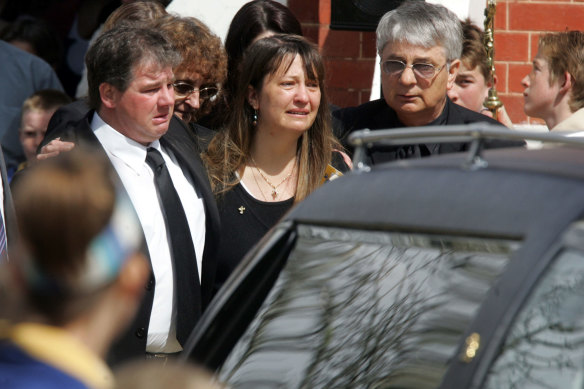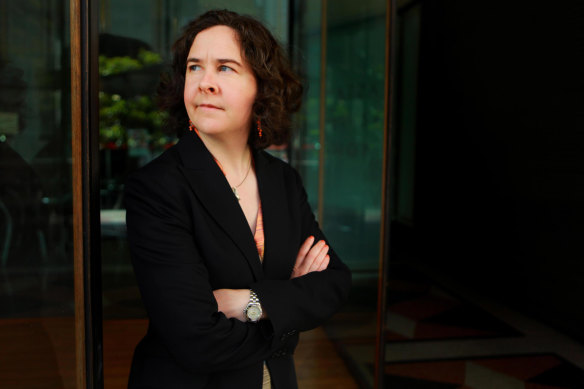- Exclusive
- National
- Victoria
- Trial by Water
This was published 4 months ago
‘I’m going to nail you for it’: Was Robert Farquharson’s prosecution a case of tunnel vision?
By Michael Bachelard and Ruby Schwartz
Robert Farquharson believed police investigators had decided that he was guilty of murdering his sons and were trying to pin the crime on him just days after the crash on Father’s Day in 2005.
Fifteen days after the boys, Jai, Tyler and Bailey, were killed when Farquharson drove into a dam, a phone tap installed by police picked up a conversation between him and his former wife, Cindy Gambino.

Robert Farquharson and Cindy Gambino at their sons’ funeral.Credit: Wayne Taylor
Farquharson was anxious about a lie detector test he was due to take that day, and Gambino had called to wish him luck. During the call, excerpts of which were played at his second trial in 2010, Farquharson told Gambino: “I feel like I’ve got to try and justify myself to everyone – to the police.
“I’ve got this feeling they want to put me away.”
A workmate of Farquharson’s also remembers him saying, early in the investigation, that a police officer had stated: “I know you’ve done it and I’m going to nail you for it.”
On conversations captured by the phone tap and played in court, Gambino echoed her ex-husband’s fears.
At the time of the comments, Farquharson had volunteered to do the lie detector test to try to prove his innocence, and he did not yet have a lawyer. He had done his formal police interview without legal advice on the basis, he said, that he had nothing to hide.
Early police conclusions about the guilt of a suspect can be an indication of a phenomenon experts call “tunnel vision”. They say this can lead investigators to focus only on evidence that suggests a suspect is guilty, and to dismiss or fail to see evidence that suggests they are innocent.
University of British Columbia law professor Emma Cunliffe has written extensively about the issue, and told the podcast Trial By Water that tunnel vision had been “heavily researched in the literature on wrongful convictions in particular”.
“There are many child homicide cases of wrongful conviction in which the question is whether there was a crime at all. And in those cases, expert witnesses, police and prosecutors might fail to notice information that tends to suggest a natural cause of death, for instance,” she said.

Professor Emma Cunliffe from the University of British Columbia.Credit: Sasha Woolley
There is no suggestion that the police in Farquharson’s case had developed tunnel vision or were ignoring evidence that might clear him, and it is also not suggested they did anything other than trying to solve what they saw as a crime. In their interactions with Farquharson, police might have been simply testing him, putting him under pressure to see if he would confess.
But in the two tapped phone calls played in court, Gambino also revealed she was nervous at the police approach to the case.
On October 1, almost a month after the crash, she told her ex-husband the police had still not taken a formal statement from her, and she was sick of being asked about their relationship when she’d repeatedly told them that she and her husband remained close.
“I think they’re just trying to find something,” Farquharson told her in the recorded conversation.
“Yeah. They’re trying to find circumstance and there’s no circumstance to find,” Gambino replied.
Two days later, police did take Gambino’s statement, in which she said: “I believe with all my heart that this was just an accident and that he would not have hurt a hair on their heads.”
After making the statement, Gambino wrote a short, undated, note in which she made her concerns about police explicit: “One month after our children died I was making my statement to [the homicide officer in charge of the investigation] Detective Gerard Clanchy and he made a comment that if Rob and I were still together this would have been looked upon as a tragic accident.”
In the document, which was gathered as part of the legal case but not tendered in court, she added: “So what does that tell you? THEORY BEFORE FACT.”
Gambino went on to complain that police knew nothing about her relationship with Farquharson, then asked: “So how can they judge … believe nothing of what you hear and only half of what you see!!!!!”
Gambino supported her former husband through his first trial and until the end of 2009. After that, she came to believe he was guilty and gave evidence against him. She died in 2022, aged 50.
Farquharson also told others he believed police were trying to pin on him a crime he had not committed. A former colleague, Mark Bean, told Trial By Water that Farquharson and Gambino had come to visit his old workplace a few weeks after the crash.
“It appeared that he’d been sedated,” Bean said. “He sort of pulled me aside and said that one of the coppers just said to [him]: ‘I know you’ve done it. And I’m going to nail you for it’.”
Asked how Farquharson had felt about that, Bean said: “Well, he’s just lost his three boys. And I think he was terribly disappointed that they actually thought that he’d do that.”
Other evidence also supports the idea that police came very early to the belief that Farquharson might be guilty. Traffic officer Sergeant Jeffery Smith told the TV documentary Crimes that Shook Australia that on the night of the crash he had written two lists under the headings: “He did it” and “He didn’t do it”.
Under the first list was a number of notes that described Farquharson’s unsettling behaviour at the scene of the crash. The only entry on the other side, Smith said, was “who could be this evil?”
In the book, On Father’s Day, author Megan Norris quotes the detective, Clanchy, saying he thought Farquharson had been “lying through his teeth” at his formal, sit-down interview when he said he only had two arms and two legs and could not save all three children.
And in a 2017 interview with then journalist Luke McMahon, Clanchy said that: “Based on the whole of the circumstances at the scene ... there was no innocent explanation at this stage, or any stage, in relation to why the vehicle went off the road into the dam.”
The evidence the police gathered to convict Farquharson has since come under serious question from a number of scientists and the Australian Academy of Science.
Police have declined to answer any questions from Trial By Water about the Farquharson case, saying in a statement that Victoria Police “stands behind the rigorous investigation which led to the 2010 conviction of Robert Farquharson”.
Farquharson’s fear of the lie detector test, captured on the phone tap, was well-founded. Even though they are unscientific and the result could not have been admitted in court, he had volunteered to undergo it to try to prove his innocence.
But on the day he took the test, its supposed result was leaked to the Herald Sun newspaper. An article the following morning – two weeks after the crash – was headlined: “Dad fails lie test. Twist in drowning tragedy.”
Despite that story, no evidence of the test’s results exist and there’s no indication that Farquharson failed it.
Asked in 2017 how the newspaper had got the story, Clanchy told an interviewer that he personally had not leaked it. However: “Do I think it came out of Vic pol? Yeah, I think it did,” Clanchy said.
Cunliffe said the effects of tunnel vision and confirmation bias were so powerful that they could affect experts giving evidence in what seem like objective areas of science.
“There has been some research that shows that if you give fingerprint examiners contextually biasing information … you can actually make them change their conclusions.”
Experts being commissioned to give evidence in criminal cases should only be shown the narrowest possible information, she said.
However, in Farquharson’s case, one crucial witness, respiratory expert Professor Matthew Naughton, was given a summary of the entire prosecution case – 25 documents – as he was preparing his opinion. Naughton disclosed in his expert statement that the Office of Public Prosecutions had provided him statements from a number of witnesses, including Greg King, who claimed Farquharson had outlined in full his plot to kill his children three months before the crash.
The opinion Naughton ultimately produced for prosecutors said it was “extremely unlikely” that Farquharson had coughed and passed out.
Asked if giving Naughton that information was appropriate, Cunliffe said: “No. I can be that categorical.
“All that should be shared with an expert witness is the minimum amount of information that is necessary to allow the expert witness to offer the opinion that is within their sphere of expertise.”
Asked if this should rule an expert out of giving evidence, Cunliffe replied: “Yes”.
There’s no suggestion Naughton’s opinion was improperly influenced, only that he should not have been shown the extraneous information. Naughton has declined to speak to Trial By Water.
Asked for their formal policy on providing information to expert witnesses, the Office of Public Prosecutions said that those decisions were made on a “case by case basis”.